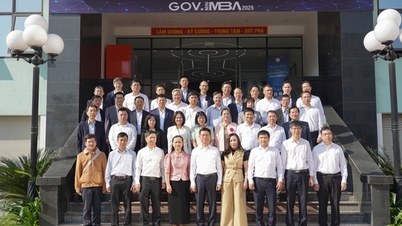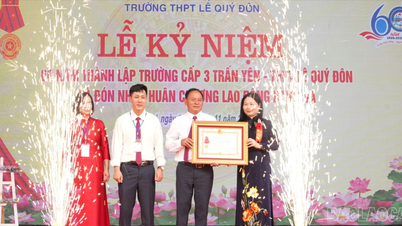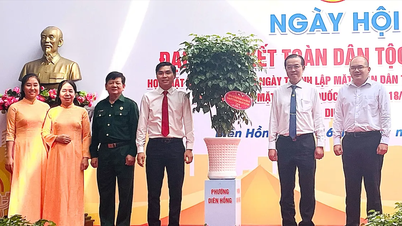Transforming the growth model to improve development quality
According to Ms. Mariam J. Sherman - World Bank Country Director for Vietnam, Cambodia and Laos: FTSE Russell's upgrading of Vietnam's market to the emerging market group not only shows the improvement in financial position but also affirms that Vietnam's persistent reforms have been recognized by the international community. This is a positive sign, helping Vietnam attract long-term investment capital for production and sustainable growth.

To achieve the goal of becoming a high-income country by 2045, Vietnam cannot continue to rely on the old growth model based on resources and cheap labor. Illustrative photo
However, to achieve the goal of becoming a high-income country by 2045, Vietnam cannot continue to rely on the old growth model, which is based on resources and cheap labor. Sharing with reporters of the Industry and Trade Newspaper on this issue, Dr. Nguyen Quoc Viet - public policy expert - University of Economics - Vietnam National University, Hanoi said: Vietnam's growth model over the past 40 years has mainly relied on capital mobilization, simple labor and expanding production scale.
Meanwhile, total factor productivity (TFP) - the decisive factor for growth quality - has not contributed adequately. Vietnam's ICOR index is still high compared to countries that have overcome the middle-income trap, showing that capital efficiency is still limited.
The complex geopolitical context and trade competition between major economies are creating significant pressure. At the same time, the Vietnamese economy is also heavily dependent on exports and external markets. This makes the Vietnamese economy vulnerable to shocks, requiring a stronger and more substantial renewal of the growth model.
In that context, Dr. Nguyen Quoc Viet said that in order to achieve the goal of becoming a developed industrial country and a high-income economy within the next 20 years, Vietnam must escape the middle-income trap and that renewing the growth model and restructuring the economy is the solution for Vietnam to achieve the goal.

Strengthening the link between the FDI sector and domestic enterprises will help Vietnam increase labor productivity. Illustrative photo
Innovation in growth model - the "key" is human resources
According to a representative of the World Bank, in reality, the labor productivity of FDI enterprises in Vietnam is currently about 70% higher than that of domestic enterprises and the salary level in this region is nearly 50% higher. However, only about 1/6 of domestic enterprises are linked to the global value chain. This gap creates challenges but also great opportunities for technology transfer, improved governance and innovation.
Accordingly, to innovate the growth model, promoting links between FDI enterprises and domestic enterprises through supplier development programs, improving quality standards and connecting supply and demand will help spread knowledge more widely throughout the economy. When domestic enterprises are able to participate more deeply in the value chain, Vietnam will gradually shift from an assembly economy to a design and manufacturing economy. This is a typical direction of countries escaping the middle-income trap.
One of the solutions to develop the private economy mentioned in Resolution 68-NQ/TW on private economic development of the Politburo is: "Strengthening the connection between private enterprises, private enterprises with state-owned enterprises and FDI enterprises" . Specifically, Vietnam will build business linkage chains according to clusters, industries, value chains, supply chains. Encourage small and medium-sized enterprises, business households. Support the development of clusters of supporting industries, processing and manufacturing industries, etc.
In addition, Vietnam needs to increase investment in human resources, because according to the World Bank representative, all reforms must start with people. Ms. Mariam J. Sherman said: Currently, only about 5.6% of workers in the processing and manufacturing industry in Vietnam have high skills and the added value that each worker creates is only about 6.7 USD, far from China's 14.4 USD.
To narrow this gap, Vietnam needs to innovate its training program towards 21st-century skills, expand STEM education, increase vocational training linked to market needs, encourage apprenticeship and work models, as well as promote public-private partnerships (PPP) in human resource training. This is a key factor to form a human resource capable of receiving high technology and participating in stages of creating greater value in production.
Agreeing with the view that people are the core factor that will help Vietnam achieve high income by 2045, Dr. Nguyen Quoc Viet said that the draft documents of the 14th National Party Congress also mentioned the content of putting people at the center, considering high-quality human resources as the center of the innovation process and changing the growth model of Vietnam.
This is one of the breakthroughs for Vietnam's economy to overcome challenges and difficulties in the current period and be able to integrate more deeply into the global economy, achieving the target of high growth by 2045.
In addition, to escape the middle-income trap, experts say that Vietnam needs to fully identify new pressures to come up with fundamental solutions. In particular, it is necessary to pay attention to transforming the growth model towards autonomy, increasing the content of science - technology and innovation in production and business activities. Because when enterprises create higher added value, the economy will be closer to the goal of escaping the middle-income trap.
One of the key solutions that can help Vietnam escape the middle-income trap and achieve the goal of becoming a high-income country by 2045 is to transform the growth model from relying on capital and labor to relying on productivity, technology and innovation. Along with that, strengthen the connection between FDI enterprises and domestic enterprises to promote technology transfer. At the same time, develop high-quality human resources through expanding STEM education and vocational training according to market needs...
Source: https://congthuong.vn/thoat-bay-thu-nhap-trung-binh-chat-luong-nhan-luc-la-then-chot-430641.html




![[Photo] Prime Minister Pham Minh Chinh meets with representatives of outstanding teachers](https://vphoto.vietnam.vn/thumb/1200x675/vietnam/resource/IMAGE/2025/11/15/1763215934276_dsc-0578-jpg.webp)

![[Photo] General Secretary To Lam receives Vice President of Luxshare-ICT Group (China)](https://vphoto.vietnam.vn/thumb/1200x675/vietnam/resource/IMAGE/2025/11/15/1763211137119_a1-bnd-7809-8939-jpg.webp)









































































































Comment (0)